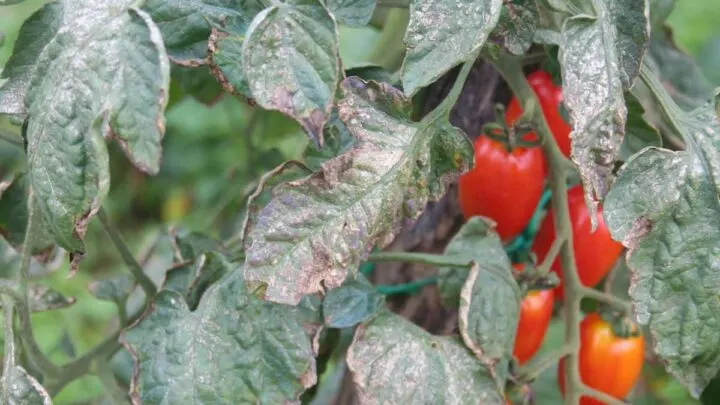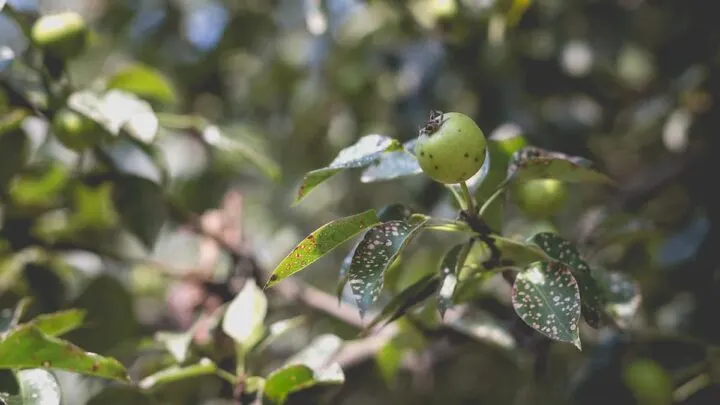Tomatoes are such a fun vegetable to grow during the summer months. It’s also so nice not to buy tomatoes from the grocery store! Sometimes, however, tomatoes do get diseases. They can happen whether you are a new or seasoned gardener; diseases may just happen no matter what we do.
Black Spots on tomato leaves can mean several things. Most likely, your tomatoes are suffering from a bacterial or fungal disease. Your garden may also be attacked by some type of pest or insect.
In today’s article, we will discuss why your tomato leaves have black spots, how it happens and if the problem can be solved. Stick around!

Reasons For Black Spots on Tomato Leaves
Now, as I mentioned, a handful of things cause black spots on tomato leaves. There are several diseases and even some pests to consider when trying to find the cause. Let’s take a look.
Diseases (Signs, Symptoms, Causes, and Cures)
Below are a few of the many diseases a tomato can have that can either start in the soil as a fungus or travel through the leaves.
1. Septoria Leaf Spot
Septoria is a fungal disease. It first begins on the plant’s lower leaves, making very small, dark spots on the leaves that almost look like watermarks. As the disease spreads, the leaves further up the plant become affected, and the spots become larger. Eventually, the disease will spread to the fruit.
This disease thrives in hot, wet conditions and happens when the plant is overwatered. It can also happen when there is a drastic change in temperature and humidity. The spores of this fungus can be spread through water, equipment, hands, really anything it touches it will spread to.
2. Blight
Blight is also a fungal disease. First appearing as 1/2-inch spots on the tomato leaves, the disease takes over quickly, and more spots will appear. As the spots grow, the leaves begin to yellow and even die. The stems of the plant will start to turn brown.
Blight is commonly caused by excess water touching the leaves in humid, warm conditions. It can be easily spread through anything that touches the fungus. There is no reversing blight once it has spread to the plant’s fruit.
However, if the fruit has not been affected yet, you can try fungicides to curb the disease. If the plant is too far gone or it’s the end of the season, burn the plant. Do not put it in the compost! This will spread the disease further. You then want to heat-treat your soil and rotate your crops.

3. Fusarium Wilt
Fusarium wilt is a nasty fungal disease for which there is no cure. It starts at the bottom of the plant, appearing as dark spots on the leaves. Rather quickly, the leaves yellow and die, and the disease travels upwards, killing off the rest of the plant.
Fusarium wilt is a soil-borne fungus that can survive in the soil for up to 10 years. It’s hard to get rid of and is a mean disease. There is absolutely nothing to be done to cure fusarium wilt. It is a fast-acting, killing disease. Your best option is to rip the plant out, burn it, heat treat your soil, and rotate your crops. However, since this is such a nasty disease and stays in the soil for so long, I recommend heat treating for 2 years without planting anything in the same soil to be safe.
4. Tomato Spotted Wilt Virus
Tomato spotted wilt appears as yellowing on the upper side of tomato leaves. This yellowing eventually turns into dark-colored spots and speckles. It will also affect the tomatoes.
Tomato Spotted Wilt Virus is a viral disease transmitted through the pests called thrips. Since this disease is brought on by thrips, the best way to ease the disease is by controlling the thrips. Otherwise, there is no curing this problem.

Bugs (Signs, Symptoms, and Cures)
1. Aphids
Aphids are tiny little bugs that are dark in color and congregate in clusters on the undersides of plant leaves. They eat through the leaves, making them look curled and yellow, and the plant’s overall growth is stunted.
Luckily aphids are fairly easy to get rid of. If it is late in the season and the fruit seems fine, you can leave the aphids alone until you rip the plant out. Otherwise, try making a spray bottle with 1 part water and 1 part vinegar, with a splash of dish soap. Spray on your plants until you see results. You can also put neem oil on and around your plants.
2. Thrips
Thrips almost look like tiny shrimps or lobsters. They are small and long, with 2 pairs of long wings. It is hard to see thrips without a magnifying glass. Thrips suck on plant cells, leaving the leaves of the plants looking depleted. Their damage can also leave black speckles and spots on the leaves.
Thrips are easily gotten rid of. You can simply pull the leaves off that are affected by thrips and use a mild natural insecticide to quickly get rid of the insect.
3. Flea Beetles
Flea beetles are extremely small-looking beetles that attack vegetable plants, including tomatoes. They feed on the leaves of the plant, chewing tiny holes throughout all the leaves.
Flea beetles can be caught in fly traps. The sticky traps catch them as they try to jump. Flea beetles will also be controlled with the same water/vinegar spray mixture you used for aphids.

Preventing Black Spots on Tomato Leaves
Most often, the diseases listed above are caused by plant stress. Plant stress can look like this:
- Underwatering
- Overwatering
- Too Hot
- Too Cold
Make sure you are watering your plants on a strict schedule to prevent any watering issues. Tomatoes need 1-2 inches of water a week. My rule of thumb is to water every other day since I live in a dry, hot climate. Check on your tomato soil daily to ensure it isn’t drying out too much. That being said, there is no need to water every day in most cases. Overwatering is perfect grounds for bacteria and fungus to grow.
Tomatoes are a summertime plant. They like full sun and temperatures of between 70-90 degrees. Anything above or below those temperatures will cause stress for the plant. Plant during the right time, and if there is cold weather, cover your plants with shade cloth, plastic, or boxes, especially at night.
Preventing pests is pretty tricky as pests are almost inevitable in any garden. Keep a close eye on your plants and look for anything out of the norm. The sooner you can stop insects from taking over, the easier it is to get rid of them.
Final Thoughts
Black spots on tomatoes are common, and there are many different causes for these black spots. From different diseases to some nasty bugs, make sure you check the symptoms to be able to treat your plants accordingly. Although some of these diseases are incurable, there are some measures you can take to try and prevent them from happening. Happy gardening!

Hi there, my name is Allie and welcome to my blog; GareningWithAllie!
Much of what you see written here is just our personal experiences with gardening. Along with the content I write here, there is also a unique collection of gardening topics covered by some of our close friends. I hope you find everything you read here to be helpful, informative, and something that can make your gardening journey the most lovely experience ever! With that said, Happy Gardening!
